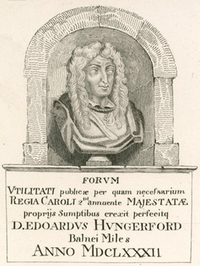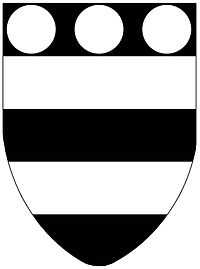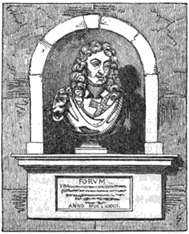Edward Hungerford (spendthrift)



Sir Edward Hungerford, KB, (20 October 1632 – 1711), was an English politician who sat in the House of Commons between 1659 and 1702. He was famous for his profligate ways and sold thirty manors, including the family seat at Farleigh Hungerford to fund his extravagant lifestyle. He founded Hungerford Market, at Charing Cross as a commercial venture.
Origins
Hungerford was the son and heir of Anthony Hungerford (1607/8-1657) by his wife Rachel Jones, daughter of Rice Jones of Asthall, Oxfordshire[2] and was baptised at Black Bourton, Oxfordshire.[3] His father was a supporter of the royalist cause in the Civil War. Hungerford was a student of Queen's College, Oxford in 1649. He succeeded to the family estates on the death of his father in 1657.[2]
Career
In 1658 Hungerford was elected Member of Parliament for Chippenham in the Third Protectorate Parliament. He was elected MP for Chippenham in 1660 for the Convention Parliament.[2] He was made a Knight of the Bath at the coronation of King Charles II on 23 April 1661.[4] In 1661 he was elected for Chippenham again in the Cavalier Parliament but the election was declared void. He was then re-elected in the by-election later in 1661 and also in the two elections in 1679. In January 1680 he presented a petition for the summoning of a parliament,[5] and his avowed opposition to the court party of King Charles II led to his removal as Lord Lieutenant of his county in May 1681.[6] He settled in Spring Gardens, Whitehall, in 1681[4] and was elected MP for Chippenham again in the Oxford Parliament of 1681. He was implicated in the 1683 Rye House Plot and his home at Farleigh Castle was searched for arms.[2] He was elected MP for New Shoreham in 1685, 1688, and 1690, and for Steyning in 1695, 1698, 1700, and 1702.
Hungerford obtained some reputation as a patron of archery, and was lieutenant-colonel of the Regiment of Archers in 1661, and colonel in 1682. However, he was best known for his reckless extravagance. He is said to have disposed of thirty manors in all. By way of restoring his waning fortunes, he obtained permission in 1679 to hold a market, on Mondays, Wednesdays, and Saturdays on the site of the demolished Hungerford House and grounds. The house, which stood on the site of the present Charing Cross railway station, had been his family's London town house and had been destroyed by fire in April 1669.[7]).[4] In 1682 a market-house was erected there, apparently to the design of Sir Christopher Wren. A bust of Sir Edward was placed on the north front, with an inscription stating that the market had been built at his expense with the king's sanction.[8] In 1685 Sir Stephen Fox and Sir Christopher Wren purchased the market and received the tolls. The market-house was rebuilt in 1833, and was removed in 1860, when Charing Cross railway station was built on the site,[9] Hungerford sold the manor and his seat at Farleigh Castle in 1686 to Henry Baynton of Spye Park for £56,000,[10] so ending centuries of ownership by the Hungerford family. In about 1700 it was purchased by Joseph Houlton of Trowbridge, in the possession of whose descendants it remained until July 1891, when it was bought by Lord Donington.[4]
Marriage & progeny
Hungerford married thrice:
- Firstly to Jane Hele (d.18 May 1664), daughter of Sir John Hele of Devonshire. She was buried at Farleigh. By her he had an only son, Edward Hungerford (1661-September 1681), who married in 1680, at the age of 19, Lady Alathea Compton, and died in September 1681. A daughter from the first marriage, Rachel (c1662-1731/32 in Co. Antrim), married, in March 1679/80, Clotworthy Skeffington, third Viscount Massereene, and left to her eldest son portraits of her father, of her granduncle (another Sir Edward Hungerford), and of other relations. In her will she mentions a brother and a sister as still living,[11]
- From this sprang: Hon. Rachael Skeffington (d.13/14 April 1739), she married firstly (1699) Randal (Mac Donnell), 4th Earl of Antrim (1680-1721), and secondly (1728) Robert Hawkins Magill (1704-1745 at Seaforde,'during a great hunting party'); High Sheriff Co. Down 1732; Trustee of the Linen Board for Munster 1736-1745; foundation member of the Dublin Society 1731; MP for County Down (1724-45); of Gill Hall, county Down; and her brother Clotworthy, 4th Viscount Massereene.
- Robert Hawkins-Magill, by his second wife Anne Bligh, daughter of John (Bligh), first Earl of Darnley by Theodosia Bligh, 10th Baroness Clifton (1695–1722), he had a daughter and heir Theodosia Meade, Countess of Clanwilliam.
- From this sprang: Hon. Rachael Skeffington (d.13/14 April 1739), she married firstly (1699) Randal (Mac Donnell), 4th Earl of Antrim (1680-1721), and secondly (1728) Robert Hawkins Magill (1704-1745 at Seaforde,'during a great hunting party'); High Sheriff Co. Down 1732; Trustee of the Linen Board for Munster 1736-1745; foundation member of the Dublin Society 1731; MP for County Down (1724-45); of Gill Hall, county Down; and her brother Clotworthy, 4th Viscount Massereene.
- Secondly to Jane Culme (d. 1674), daughter of Hugh IV Culme (1601-1643/4) of Canonsleigh Abbey and Molland-Champson in Devon and heiress of her brother Richard II Culme (d.1658/9),[12] and by whom he seems to have left issue.[13]
- Thirdly to Jane Digby, perhaps the Lady Hungerford who died on 23 November 1692[14] and by whom he seems to have left issue.[13]
Death & burial
In his old age Hungerford is stated to have become a poor knight of Windsor. He died in 1711 and was buried in the church of St. Martin's-in-the-Fields.[15] With the death of Sir Edward, the notable history of the family of Hungerford of Farleigh practically closes.[13]
Notes
- ↑ Gentleman's Magazine, 1832, part 2, p.113
- ↑ 2.0 2.1 2.2 2.3 , Hayton & Lancaster 1983.
- ↑ Lee 1891, p. 255 cites: Notes and Queries, 4th ser. vi. 454, by Canon Jackson.
- ↑ 4.0 4.1 4.2 4.3 Lee 1891, p. 255.
- ↑ Lee 1891, p. 255 cites: Luttrell, Brief Relation, i. p. 32.
- ↑ Lee 1891, p. 255 cites: Luttrell, Brief Relation, i. p. 89.
- ↑ Lee 1891, p. 255 cites: Peyps, Diary, iv. 161.
- ↑ Lee 1891, p. 255: see drawing in Gent. Mag. 1832, pt. ii. p. 113.
- ↑ Lee 1891, p. 255 cites: Cunningham, Handbook to London, ed. Wheatley, ii. 248-9.
- ↑ Lee 1891, p. 255 cites: Luttrell, i. 395.
- ↑ Lee 1891, p. 256 cites: Lodge, Irish Peerage, ed. Archdall, ii. 384-5 ra.
- ↑ Vivian, Heralds' Visitations of Devon (1895), pp.262-3
- ↑ 13.0 13.1 13.2 Lee 1891, p. 256.
- ↑ Lee 1891, p. 256 cites: Lutrell, ii. 623.
- ↑ Lee 1891, pp. 255–256.
References
- Hayton, D. W.; Lancaster, Henry (1983). "Hungerford, Sir Edward (1632-1711), of Broadwater, Suss.". The House of Commons, 1660–1690 1. Boydell & Brewer. pp. 163–164. ISBN 0-436-19274-8.
Attribution
 This article incorporates text from a publication now in the public domain: Lee, Sidney (1891). "Hungerford, Edward (1632-1711)". In Lee, Sidney. Dictionary of National Biography 28. London: Smith, Elder & Co. pp. 255–256.
This article incorporates text from a publication now in the public domain: Lee, Sidney (1891). "Hungerford, Edward (1632-1711)". In Lee, Sidney. Dictionary of National Biography 28. London: Smith, Elder & Co. pp. 255–256.
- Hoare's Hungerfordiana, 1823;
- Jackson's Guide to Farleigh-Hungerford, 1853;
- Gent. Mag. 1832, pt. ii. 113-15;
- Burke's Extinct Peerage, s.v. 'Hungerford of Heytesbury;' Burke's Vicissitudes of Families, 1st ser.;
- Notes and Queries, 5th ser. ii. 293.
Further reading
- D Brunton & D H Pennington, Members of the Long Parliament (London: George Allen & Unwin, 1954)
- Concise Dictionary of National Biography (1930)
- Burke, Sir Bernard, Vicissitudes of Families, relates the downfall of the Hungerford family
| Parliament of England | ||
|---|---|---|
| Preceded by Not represented in Second Protectorate Parliament |
Member of Parliament for Chippenham 1659 With: James Stedman |
Succeeded by Not represented in Restored Rump |
| Preceded by Not represented in Restored Rump |
Member of Parliament for Chippenham with Edward Poole 1660–1661 Henry Bayntun 1661 1660–1661 |
Succeeded by Henry Bayntun Sir Hugh Speke |
| Preceded by Henry Bayntun Sir Hugh Speke |
Member of Parliament for Chippenham with Henry Bayntun 1661–1673 Francis Gwyn 1673–1679 John Talbot 1679 Samuel Ashe 1679–1681 Sir George Speke 1681–1685 1661–1685 |
Succeeded by Henry Bayntun Sharington Talbot |
| Preceded by John Hales Robert Fagg |
Member of Parliament for New Shoreham with Sir Richard Haddock 1685–1689 John Monke 1689–1690 John Perry 1690–1695 1685–1695 |
Succeeded by John Perry Henry Priestman |
| Preceded by Sir John Fagg Robert Fagg |
Member of Parliament for Steyning with Sir John Fagg 1695–1701 Sir Robert Fagg 1701 Charles Goring 1701 1695–1701 |
Succeeded by Charles Goring Robert Fagg |
| Preceded by Charles Goring Robert Fagg |
Member of Parliament for Steyning with Charles Goring 1702–1705 |
Succeeded by Charles Goring William Wallis |